The
|

|
Welcome to my independent research project on
at
Mepal (Fortrey's Hall) Pumping Station, Engine Bank, Mepal
early draft new page, revision 2 (note, much more to be added)
Introduction
This pumping station is situated at Engine Bank, Mepal, to the west of the Washes (the opposite side to the village of Mepal) on the west side of the Counter Drain into which it discharges.It is owned and operated by the Sutton & Mepal Internal Drainage Board (S&M IDB). The drainage district was formed by Act of Parliament in 1749 covering approx 9,000 acres of fen west of the Washes, increased to 10,348 by 18404.. The 2012 IDB plan shows the rateable area is now 4680 hectares, some 11,565 acres, and the Board also has to drain some additional "highland" catchment areas on its north-west and southern borders.
For nearly 100 years it was drained by wind-powered scoopwheels (usually called windmills or wind pumps).
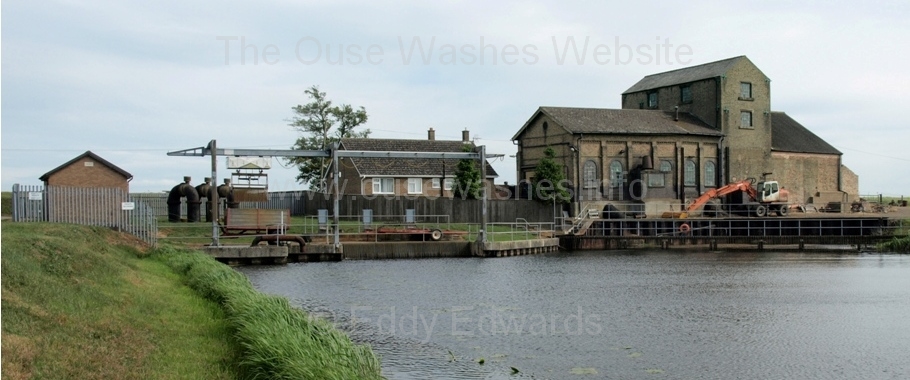
Photo: EE, May 2011
Above, left to right: the small brick building is the 1990 electric pump control room; three discharge pipes from the submerged electric pumps; weed grab above cart; pipe from IDBs northern drain; pumping station cottage (1970); weedscreen below trailer; the 1927-28 diesel engine house; the 1840 steam engine building; and workshop, previously boiler house?
And this is how it looks from the east side of the Counterdrain
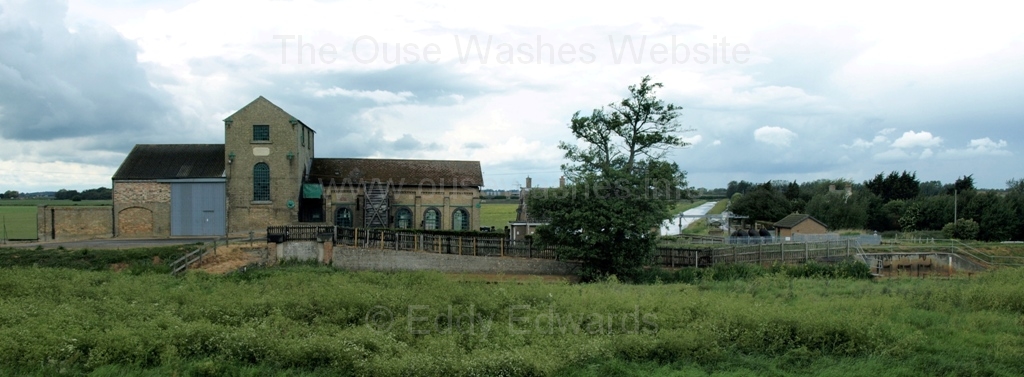
Photo: EE, May 2011
Potted history
| period | engine: make model, type, fuel | rating hp | pump | tpm | m3/s | head | acres drained |
discharge/remarks/other | refs |
| 1749 | six wind-mills | ||||||||
| 1840-1927 | Butterley steam beam |
80hp | scoopwheel 32ft2,4 or 34ft3 diam, 4ft wide |
10,348 | replaced 6 windpumps | 2, 3 | |||
| 1884 | 36ft diam in use | 120 | 2,4 | ||||||
| 1927-1939 | Vickers-Petters 4-cyl vertical 2-stroke hot-bulb diesel |
250 hp | No.1:
Gwynnes 42" centrifugal |
150 | engine disintegrated when started in 1939 Replaced with Brush driving the original pump | ||||
| 1927-1947 | Vickers-Petters 4-cyl vertical 2-stroke hot-bulb Diesel |
250 hp | No 2: Gwynnes 42" centrifugal | 150 | removed 19473replaced by Ruston Hornby | ||||
| 1939 | Brush, 4M13 4-cyl horizontal opposed diesel |
250 hp at 250 rpm |
No.1: Gwynnes 42" centrifugal | 150 | engine and pump in situ 2013 but not used for many years due to damaged foundations. It was run for a few minutes in June 19895 | ||||
| 1949-now | Ruston & Hornsby 5VEBX (no 282122) 5 cyl vertical 4 stroke diesel |
300 bhp at 500 rpm |
No 2: Gwynnes 42" centrifugal |
200 | 2.55? | Stand-by/
supplementary since 1990. Use Dec 2012-Jan 2013 after v heavy rains |
|||
| 19903-now | 3 x Flygt electric submersible |
tot 3.0 |
11,565 | Automatic operation. Small brick control building. New intake. Three new discharge pipes with syphon valves. | 1 |
Early diesel engines were known as "oil"engines.
| ref | source |
| 1 | David Stimson, Sutton & Mepal IDB District Officer |
| 2 | David J Sanders: Draining the Fen with particular reference to the parish of Mepal, 1998 |
| 3 | KSG Hinde: Fenland Pumping Engines |
| 4 | Richard L Hills: Machines Mills & Uncountable Costly Necessities, 1967 |
| 5 | Chris Allen, Stationery Engine Research Group (SERG) |
| 6 | Acts of Parliament of 1748-9, 1777 and 1806 (copies in the collection of Eddy Edwards) |
back to contents
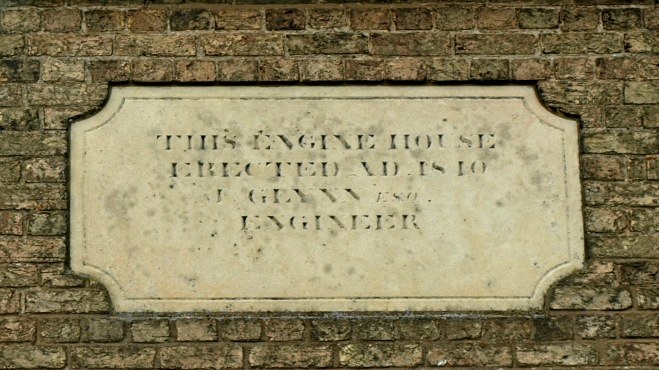
Photo: Eddy Edwards, May 2011
Steam Power
The IDB's records show the steam plant was built in 1840 although many people think it was 1810 because the date on the wall plaque between the two windows of the tall engine house has weathered. Click photo to see the correct year.An 80hp Butterley steam beam-engine designed by Joseph Glynn was installed driving a scoopwheel 34ft in diameter & 4ft wide, said to discharge 120 tons per minute (tpm). It drained 10,500 acres and replaced six wind pumps.
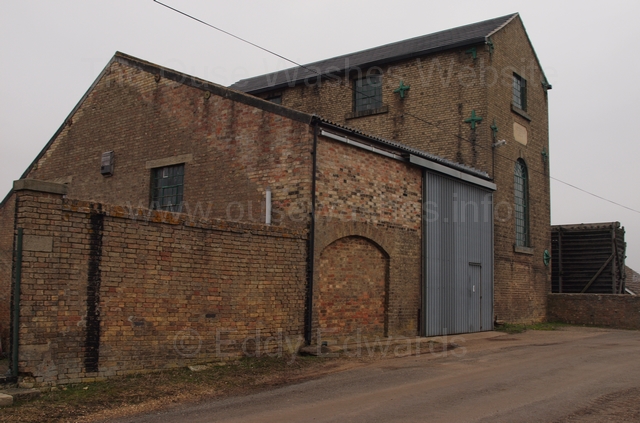 Photo: Eddy Edwards, Feb 2013 |

Photo: Eddy Edwards, May 2011 |
The discharge point can still be seen, albeit bricked up, below the level portion of wooden fencing. ing.
 Photo: Eddy Edwards, Feb 2013 |

Photo: Eddy Edwards, May 2011 |
Date of construction above window
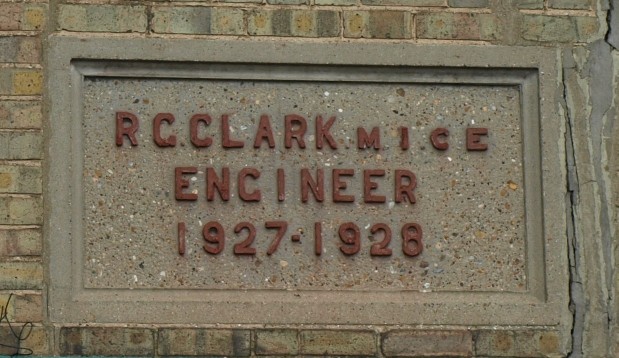
Photo: Eddy Edwards, May 2011
Diesel
In 1925 the District Commissioners decided to replace the steam station with a diesel-fuel driven one. In August that year they considered ten tenders, choosing the two lowest, from Vickers-Petters (V-P) for a 2-stroke engine, and from Blackstone for a 4-stroke, to be put to the Unemployment Grants Committee who would subsidise the cost. There was much discussion about the relative merits of 2-stroke and 4-stroke engines, with the V-P eventually winning by 12 votes to 8. (I am indebted to David J Sanders for much of this information2.)A new brick building to house the new plant was erected, joined to the steam-engine house after the scoop wheel house was demolished. Other equipment included two vertical sluice valves to control discharge and pump primers.
The Commissioner's borrowing power was increased to £15,000 under The Sutton and Mepal Drainage Order 1926, presumably to help pay for the works, and further increased to a total of £21,000 by an order of 1929.
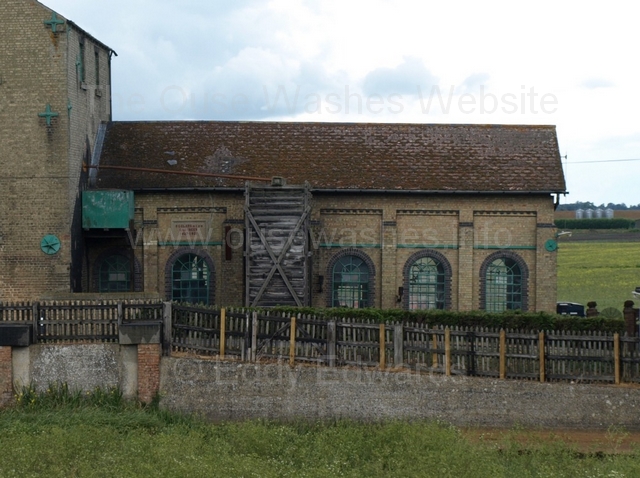 Photo: Eddy Edwards, May 2011
Photo: Eddy Edwards, May 2011Vickers-Petters engines
Two 4-cyl vertical 2-stroke diesel engines rated at 250hp were installed in 1927, each driving a 42inch Gwynnes centrifugal pump discharging 150 tpm3. These engines used the "hot-bulb" method of ignition, which involved starting with compressed-air driven paraffin blow lamps fitted at the top of each cylinder. Hinde says they were unreliable. One apparently one blew up in 1939 and this time just two tenders were received, from Brush (for a secondhand machine), and from Allen & Sons; the Brush was slightly cheaper and was accepted. The other Vickers-Petters remained until 1949 when it was replaced with a Ruston & Hornsby .Brush engine
This was a 4-cyl horizontally opposed 4-stroke diesel, model 4M13, originally rated at 380bhp at 333rpm, but reduced to 250bhp at 250rpm to be compatible to the existing 1927 Gynnes pump which it drove3. It was built in 1935 and first installed in a mill before being moved here in 19391. This engine, like the majority of large diesels of the period, was started using compressed air at 300 pounds per sq.inch (psi) to turn the engine over, and an air-compressor and air receiver were needed.
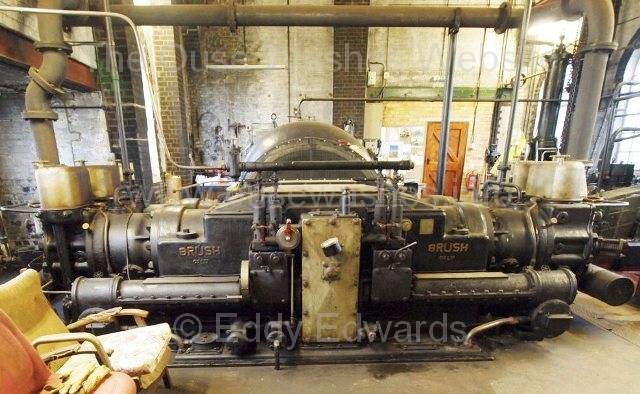 Photo: Eddy Edwards, Feb 2013 "front" view of the Brush |
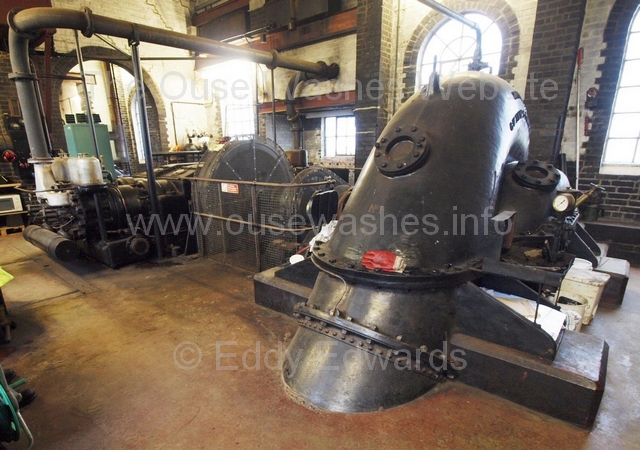 Photo: Eddy Edwards, Jan 2013 rear of Brush, drive belts under wire guard, and the pump |
Ruston and Hornsby engine
In 1949 a 5cyl vertical diesel type 5VEB, rated at 300 bhp at 500rpm, was installed in the old steam house and connected to the other 1927 Gwynnes 42-inch centrifugal pump by 20 V belts.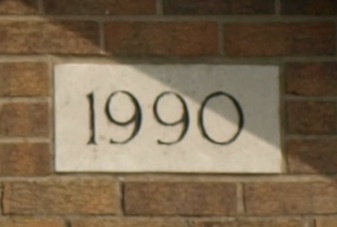
Wall plaque on electric pump-house
Photo: Eddy Edwards, May 2011
Electric
The station was converted to electric power in 1990 with new inlet and outlet points and three new auto-controlled submersible pumps with a total capacity of 3.00 m3/sec, and an automatic weed grab. Photo: Eddy Edwards, May 2012
Photo: Eddy Edwards, May 2012back to contents
Irrigation Slacker
back to contents
Management
Sutton & Mepal IDB - Board Members
| Name | From | in | To | Position | representing |
| Allan, A | 2011 | ||||
| Allpress, P | 2011 | ||||
| Angood, RJ | 2011 | ||||
| Deamer, J | 2011 | ||||
| Heading HJ | 2011 | ||||
| Lack IR | 2011 | Huntingdon DC | |||
| Latta, M | 2011 | ||||
| Lee, C | 2011 | ||||
| Lee, RJ | 2011 | ||||
| Pearson, RC | 2011 | ||||
| Robinson, PB | 2011 | ||||
| Scott, T | 2011 | ||||
| Smith, RH | 2011 | ||||
| Sole, JO | 2011 | ||||
| Sole, P | 2011 | ||||
| Veal, EF | 2011 | ||||
| Wilkinson, AS | 2011 | Chairman 2011 |
District Officer
| Name | From | in | To | Phone | mobile |
| Stimson, David | 2011 | 01353 778230 | 07747 803758 |
Contact Details
e:mail: admin@middlelevel.gov.uk, phone: 01354 653232Bungalow
|
Acknowledgements. Text and photos except where noted © Eddy Edwards, 2010-12 If you think there are any errors or ommissions on this page or would like to comment, please e-mail me and your response will be noted where appropriate. |
Index and links
back to contents